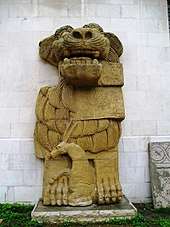Lion of Al-lāt
The Lion of Al-lāt (Arabic أسد اللات) is an ancient statue that adorned the Temple of Al-Lat in Palmyra, Syria. On 27 June 2015, it was severely damaged by the Islamic State of Iraq and the Levant after it had captured Palmyra.[1] The statue was removed to the National Museum of Damascus and underwent reconstruction work, and now stands again.[2]
 The Lion of Al-lāt, 2010 | |
| Coordinates | 34.5542°N 38.2667°E |
|---|---|
| Location | Temple of Al-Lat, Palmyra, Syria |
| Material | Limestone |
| Height | 3.5 m (11 ft) |
Description
The statue, of a lion holding a crouching gazelle, was made from limestone ashlars in the early first century A.D. and measured 3.5 m (11 ft) in height,[3] weighing 15 tonnes.[1] The lion was regarded as the consort of Al-lāt.[3] The gazelle symbolized Al-lāt's tender and loving traits, as bloodshed was not permitted under penalty of Al-lāt's retaliation.[4] The lion's left paw had a partially damaged Palmyrene inscription (PAT 1122) which reads: tbrk ʾ[lt] (Al-lāt will bless) mn dy lʾyšd (whoever will not shed) dm ʿl ḥgbʾ (blood in the sanctuary).[5]
History

The statue was discovered in 1977 by a group of Polish archeologists working under Prof. Michał Gawlikowski.[6] It was found in pieces, having been reused in antiquity for the temple's foundation.[6] Subsequently, it was decided to reassemble the pieces in front of the entrance to the Palmyra Museum. The task was undertaken by restorer Józef Gazy. In 2005, it underwent restoration to eliminate problems from assemblage.[6] Ultimately, the piece was restored in imitation of its original intended appearance – a relief jumping out from a wall.[6] During the Syrian Civil War the statue was shielded with a metal plate and sandbags to protect it from fighting.[1]
On 27 June 2015, it was severely damaged by the Islamic State of Iraq and the Levant after it had captured Palmyra.[1] After the liberation of Palmyra by the Syrian army, Syria's director-general of antiquities and museums Maamoun Abdulkarim declared that the pieces were still in place and it should be possible to put them back together, giving hopes for reconstruction.[7] The statue was moved to Damascus in 2016, where it underwent complete restoration.[8] On 1 October 2017, it was fully restored, and is currently on display in the National Museum of Damascus, until safety is assured in Palmyra to move it there again.[2]
See also
| Wikimedia Commons has media related to Lion of Al-lāt. |
References
- "Isis militants destroy 2,000-year-old statue of lion at Palmyra". The Guardian. Retrieved 3 July 2015.
- "Restoration works of Palmyra's famous ancient statue of Lion of Allat completed – Syrian Arab News Agency". sana.sy. Retrieved 27 June 2018.
- Kevin Butcher (2003). Roman Syria and the Near East. Getty Publications. p. 309. ISBN 0892367156.
- Theodorus Petrus van Baaren (1982). Commemorative Figures. Brill Archive. p. 70. ISBN 9004067795.
- Van Baaren (1982), p. 65 and Reinhard G. Lehmann: “Kein Blutvergießen!” Die Löweninschrift der ʾAllāt von Palmyra, in: ḤBL Tadmor. Studies in Palmyrene Script and Language. KUSATU 23 (2018), pp. 3-8.
- Bartosz Markowski. "The Lion of Allat in Palmyra New Museum Display Project" (PDF). Polish Centre of Mediterranean Archaeology. Archived from the original (PDF) on 4 July 2015. Retrieved 3 July 2015.
- "Palmira prima e dopo l'ISIS". Il Post (in Italian). 28 March 2016. Retrieved 31 March 2016.
- "تمثال أسد اللات.. من تدمر إلى المتحف الوطني في دمشق استعداداً لترميمه (In Arabic)". Retrieved 21 July 2017.